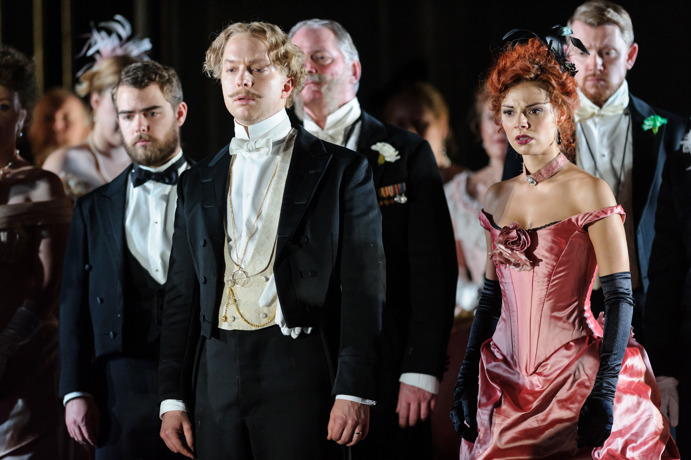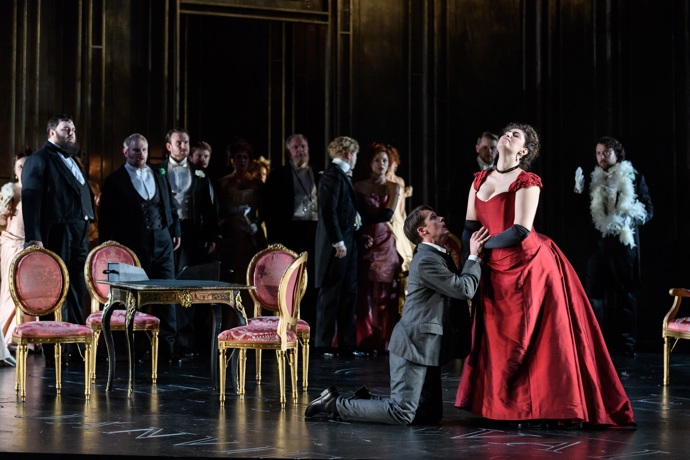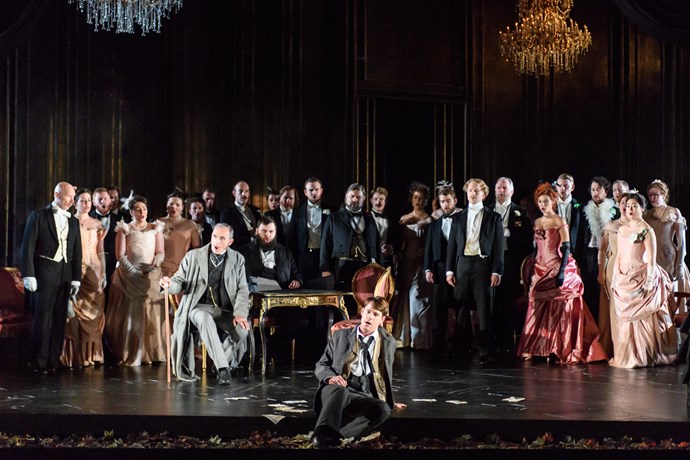La Traviata at Theatre Royal
If you're like me and you've never been to a traditional opera then you will have no idea what to expect other than that the bar will be extortionate, people will be speaking in very posh accents and everyone going will be dressed in their best occasion-wear. Though all of these are true, don't feel that this means you have to dress up in a sequined gown and feather boa - you'll be just as welcome in your comfiest clothes and trainers.
Karlie and I arrived about 45 minutes before the show was due to start - this meant we had time for a catch up and a large glass of wine before taking our seats. The last time I was at Theatre Royal we sat in the stalls for Bluebeard's Castle and the 8th Door back in March - and that was a completely different experience because it was a collaboration with artist-led theatre company, Vanishing Point, a modern take on a classic. This time around we opted for seats in the Dress Circle and I think the view was better from here.
Verdi's La Traviata is an Italian opera set in the 1880's in Paris and the costumes and set design fit in with this period - the men were in three-piece suits complete with impressive beards, moustaches and sideburns; and the ladies were corseted up in lavish satin and velvet gowns. The set consisted of dark gothic fabrics and plush Victorian looking furniture with a frosted glass wall at the back of the stage which acted as the cast's entrance and exit.
The opening scene sees the stage split into two parts by a low-hanging curtain. The foreground consists of the very front edge of the stage covered in leaves, the background a room full of furniture covered in cloth dust sheets with several men taking stock of the belongings. A man walks slowly across the front of the stage stopping to pick up and look at one of the leaves for a moment before continuing to walk across and off the stage. The curtain creeps slowly upwards to create a wall of ruched and textured black fabric that hangs the entire height of the stage - this was very pleasing to watch. Suddenly the curtain is yanked up diagonally to reveal a stage full of people in period dress laughing and cavorting at a party, then they break into song about pleasure and satisfying their desires accompanied by the orchestra who sit beneath the stage. The lyrics were translated on a supertitles screen above the stage which was a really fantastic addition as it meant I could finally put meaning to the songs I'd heard in music class in high school.
The story is a classic tragic love story which makes it easier to follow the songs. To summise the plot for you: love is confessed by Alfredo to Violetta who doesn't believe him but decides to give him a chance. The next scene is set 3 months later, Alfredo and Violetta have been living together and he finds out that she has been spending all of her money on them, and thus has started to sell off her possessions to continue doing so. Alfredo heads off to Paris to sort out their money situation, meanwhile his father visits Violetta and begs her to leave him as his family has been disgraced by his leaving and thus his daughter's suitor will not marry her. Reluctantly she leaves him and goes back to Paris and her friends. Alfredo follows, not knowing of the deal his father has struck, begging her to return to him before embarrassing her at the party throwing money at her in contempt to 'pay her back in full'.
The scene ends and the next is Violetta ill-stricken in bed, waiting for Alfredo to return to her. He and his father return, begging forgiveness, but alas it is too late and Violetta dies in Alfredo's arms.
Each scene was cleverly designed to make use of the space with different black and white curtains closing off different sections of the stage, making it look like several rooms. The black fabric of the curtains echoing the weightiness of the narrative.
Three hours and four intermissions later and the applause was deafening. I laughed a lot, I almost cried, and I wanted to watch it all again. There was something just so magical about witnessing these classic songs come to life, like watching an impressionist painting coming to life.
If you're unsure about whether or not the opera is for you all I can say is go and find out for yourself. You don't need to dress up, and with reduced price tickets for Under 26's - you can always leave at an intermission if it's just not for you.
Personally, I can't wait for the next opera to come to town!
- Melissa x
Karlie and I arrived about 45 minutes before the show was due to start - this meant we had time for a catch up and a large glass of wine before taking our seats. The last time I was at Theatre Royal we sat in the stalls for Bluebeard's Castle and the 8th Door back in March - and that was a completely different experience because it was a collaboration with artist-led theatre company, Vanishing Point, a modern take on a classic. This time around we opted for seats in the Dress Circle and I think the view was better from here.
Verdi's La Traviata is an Italian opera set in the 1880's in Paris and the costumes and set design fit in with this period - the men were in three-piece suits complete with impressive beards, moustaches and sideburns; and the ladies were corseted up in lavish satin and velvet gowns. The set consisted of dark gothic fabrics and plush Victorian looking furniture with a frosted glass wall at the back of the stage which acted as the cast's entrance and exit.
The opening scene sees the stage split into two parts by a low-hanging curtain. The foreground consists of the very front edge of the stage covered in leaves, the background a room full of furniture covered in cloth dust sheets with several men taking stock of the belongings. A man walks slowly across the front of the stage stopping to pick up and look at one of the leaves for a moment before continuing to walk across and off the stage. The curtain creeps slowly upwards to create a wall of ruched and textured black fabric that hangs the entire height of the stage - this was very pleasing to watch. Suddenly the curtain is yanked up diagonally to reveal a stage full of people in period dress laughing and cavorting at a party, then they break into song about pleasure and satisfying their desires accompanied by the orchestra who sit beneath the stage. The lyrics were translated on a supertitles screen above the stage which was a really fantastic addition as it meant I could finally put meaning to the songs I'd heard in music class in high school.
The story is a classic tragic love story which makes it easier to follow the songs. To summise the plot for you: love is confessed by Alfredo to Violetta who doesn't believe him but decides to give him a chance. The next scene is set 3 months later, Alfredo and Violetta have been living together and he finds out that she has been spending all of her money on them, and thus has started to sell off her possessions to continue doing so. Alfredo heads off to Paris to sort out their money situation, meanwhile his father visits Violetta and begs her to leave him as his family has been disgraced by his leaving and thus his daughter's suitor will not marry her. Reluctantly she leaves him and goes back to Paris and her friends. Alfredo follows, not knowing of the deal his father has struck, begging her to return to him before embarrassing her at the party throwing money at her in contempt to 'pay her back in full'.
The scene ends and the next is Violetta ill-stricken in bed, waiting for Alfredo to return to her. He and his father return, begging forgiveness, but alas it is too late and Violetta dies in Alfredo's arms.
Each scene was cleverly designed to make use of the space with different black and white curtains closing off different sections of the stage, making it look like several rooms. The black fabric of the curtains echoing the weightiness of the narrative.
Three hours and four intermissions later and the applause was deafening. I laughed a lot, I almost cried, and I wanted to watch it all again. There was something just so magical about witnessing these classic songs come to life, like watching an impressionist painting coming to life.
If you're unsure about whether or not the opera is for you all I can say is go and find out for yourself. You don't need to dress up, and with reduced price tickets for Under 26's - you can always leave at an intermission if it's just not for you.
Personally, I can't wait for the next opera to come to town!
- Melissa x




